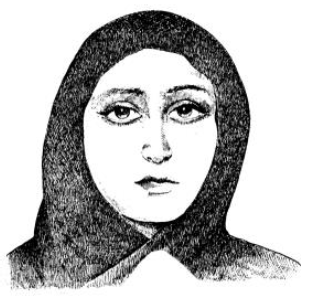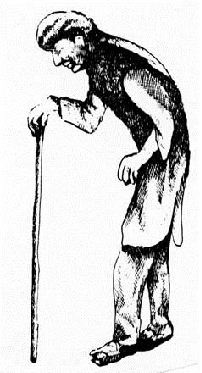Lesson Six
Dialogue six: A guest at your door
L: pu khayr ráaghle. Welcome. | په خیر راغلې. |
L: hăr kala ráasha. Always welcome. | هر کله راشه. |
L: kéna! kéna! Sit! Sit! | کښېنه! کښېنه! |
L: chaay kho ba skoo, kho awál raa-ta oowaaya che DoDuy de khoRule da, ka na? We will drink tea, but first tell me if you have eated food, or not? | چائې خو به څښُو، خو اول راته ووایه چې ډوډۍ دې خوړلې ده، که نه؟ |
H: nu me da khoRule. ku taa ta tukléef nu wee, no Teek da. I haven't eaten. If it's no trouble to you, then fine. | نهٔ مې ده خوړلې. کهٔ تا ته تکلیف نهٔ وی نو ټیک ده. |
L: che tsu tayaar wee haghá du yaar wee. Whatever is ready is for a friend. | چې څۀ تيار وى هغه د يار وى. |
H: bas Teek da. That's OK. | بس ټیک ده. |
L: tu khu ye? Are you fine? | تهٔ ښهٔ یې؟ |
H: aaw, khu yim. Yes, I'm fine. | آو، ښه یم. |
L: kor ke khay day, baal buch de khu day? khay kho day ka na, tsunga raaghle? Is everything OK at your house? Are the children OK? Is everything fine? Why did you come? | کور کښې خیر دے، بال بچ دې ښۀ دے؟ خیر خو دے کنه، څنګه راغلې؟ |
H: zmaa lug kaar day no zmaa khayáal day che taa sara ba shpa oókum. I have a little work and I think I will spend the night with you. | زما لږ کار دے نو زما خيال دے چې تا سره به شپه وکم. |
L: Der de khu ooka. You did very well. | ډېر دې ښۀ وکه. |
NOTE:
Unstinting hospitality is a highly cherished virtue in Pukhtun society.
Pronunciation drill
- Contrasting غ - gh and خ - kh
| ghadáar me óoleedo. | I saw a deceitful man. | غدار مې ولیدو. |
| khor me ooleeda. | I saw a sister. | خور مې ولیده. |
| daa ghwaa da. | This is a cow. | دا غوا ده. |
| da khwaa da. | This is the side. | دا خوا ده. |
| dágha ghur day. | This is a mountain. | دغه غر دے. |
| dágha khur day. | This is a donkey. | دغه خر دے. |
| daa gháTa da. | This is big. | دا غټه ده. |
| daa kháTa da. | This is mud. | دا خټه ده. |
Try this tongue twister:
- Contrasting و - o and هٔ or unwritten in script - u
| tso lare? | How many do you have? | ځو لرې؟ |
| tsu lare? | What do you have? | څهٔ لرې؟ |
| day moR sho. | He is full (from eating). | دے موړ شو. |
| day muR sho. | He died. | دے مړ شو. |
A complete listing of subject pronouns and the present equative
| Person | Pronoun/Verb (Singular) | Pronoun/Verb (Plural) | ||||||||
|---|---|---|---|---|---|---|---|---|---|---|
1st | zu yim | I am | زه یم. | moong yoo | we are | مُونږ یو | ||||
2st | tu ye | you are | ته یې | táaso yey | you are | تاسو یئ | ||||
3rd |
| he is |
| haghwée dee | they are | هغوی دی | ||||
| she is |
| dwee dee | they are | دوی دی | |||||
NOTES:
You will hear speakers using both هغی - haghee and هغوی - haghwee to mean 'they’; referring to people who are being talked about, but who are not present.
- دوی - dwee is used to describe more than one person or animal; referring to people / animals which are close at hand and visible.
Commonly anything close at hand is often called دا - daa (demonstrative pronoun), but it is only by listening to the verb ending that you know whether this refers to 'he’, 'she’, 'they’, etc.
Feminine Plural Nouns
| taa sara tsoomra churge shta? | How many hens do you have? | تا سره څومره چرګې شته؟ |
| tsoomra kUrsúy pukáar dee? | How many chairs are needed? | ځومره کُرسۍ پکار دی؟ |
| taaso taalibilmáane yey? | Are you (female) students? | تاسو طالبعلمانې یئ؟ |
| dwee DakTuráane dee? | Are they (female) doctors? | دوی ډاکټرانې دی؟ |
| haghwee narsaane dee | They are nurses. | هغوی نرسانې دی. |
NOTE:
Feminine nouns ending in ه - a change the ending to ې - e in the plural. Feminine nouns ending in ۍ - uy do not change in the plural. Others use an انې - aane ending to show plurality.
Feminine plural adjectives
| Pronoun | Adjective | Verb | |
|---|---|---|---|
moong | stuRe | yoo | We are tired. مُونږ ستړې یو. |
haghwee | khkÚle | dee | They are beautiful. هغوی ښکُلې دی. |
táaso | jóRe | yey? | Are you well? تاسو جوړې یئ؟ |
hágha | gháTe | dee | Those are big. هغه غټې دی. |
daa | drane | dee | They are heavy. دا درنې دی. |
NOTE:
The 3rd person plural form of the equative دی - dee is the same for both genders, so only the adjective ending indicates gender.
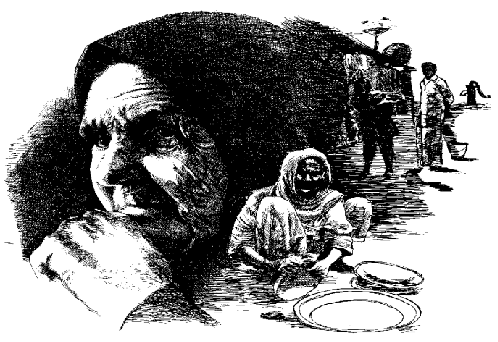
Some useful adjectives in their masculine and feminine forms
It would help to memorize the following chart:
| Masculine singular | Masculine plural | Feminine singular | Feminine plural |
|---|---|---|---|
arzáan cheap, inexpensive ارزان | arzáan ارزان | arzáana ارزانه | arzáane ارزانې |
badrúnga ugly بدرنګه | badrúnga بدرنګه | badrúnga بدرنګه | badrúnge بدرنګې |
bud bad, incorrect بد | bud بد | búda بده | búde بدې |
booDáa elderly بُوډا | booDaagáan بُوډاګان | booDúy بُوډۍ | booDúygáane بُوډۍ ګانې |
pakhwaanáy old, ancient, former پخوانے | pakhwaanée پخوانی | pakhwaanúy پخوانۍ | pakhwaanúy پخوانۍ |
túgay thirsty تږے | túgee تږی | túge تږې | túge تږې |
takRá strong تکړه | takRá تکړه | takRá تکړه | takRá تکړه |
kharáab bad, ruined, faulty خراب | kharáab خراب | kharáaba خرابه | kharáabe خرابې |
khufá, khupá sad, mad خفه | khufá, khupá خفه | khufá, khupá خفه | khufá, khupá خفه |
droond heavy دروند | draanú درانهٔ | draná درنه | drané درنې |
zoR old زوړ | zaaRú زاړه | zaRá زړه | zaRé زړې |
jzwandáy alive ژوندے | jzwandée ژوندی | jzwandúy ژوندۍ | jzwandúy ژوندۍ |
spuk light سپک | spuk سپک | spúka سپکه | spúke سپکې |
stúRay tired ستړے | stúRee ستړی | stúRe ستړې | stúRe ستړې |
sust weak, lazy سست | sust سست | susta سسته | suste سستې |
khaaystá pretty ښائسته | khaaystá ښائسته | khaaystá ښائسته | khaaystá ښائسته |
khkÚlay pretty ښکُلے | khkÚlee ښکُلی | khkÚle ښکُلې | khkÚle ښکُلې |
khu good ښهٔ | khu ښهٔ | kha ښه | khe ښې |
ghaT big, large, fat غټ | ghaT غټ | gháTa غټه | gháTe غټې |
kooN deaf کوڼ | kaaNú کاڼه | kaNá کڼه | kaNé کڼې |
graan expensive, dear ګران | graan ګران | gráana ګرانه | gráane ګرانې |
lug little, few لږ | lug لږ | lúga لږه | lúge لږې |
lunD short لنډ | lunD لنډ | lúnDa لنډه | lúnDe لنډې |
lwuR high, tall لوړ | lwuR لوړ | lwúRa لوړه | lwúRe لوړې |
looy big, great لوئ | looy لوئ | lóoya لویه | lóoye لویې |
muR dead مړ | mRu مړهٔ | mRa مړه | mRe مړې |
moR full موړ | maaRú ماړهٔ | maRá مړه | maRé مړې |
naráy thin نرے | narée نری | narúy نرۍ | narúy نرۍ |
waRóokay small وړُوکے | waaRú واړهٔ | waRá وړه | waRé وړې |
wúgay hungry وږے | wúgee وږی | wúge وږې | wúge وږې |
👆 Practice the use of these adjectives until they become second nature. Using the illustrations in Picture it in Dari and Pashto or generating some simple pictures to go with this chart will enable you to practice these adjectives with your language helper as well as illiterate friends. Find pictures of masculine singular and plural, and feminine singular and plural objects, then get your helper or friend to drill you. Here is an example using trees and books with the adjectives غټ - ghaT and ارزان - arzáan:
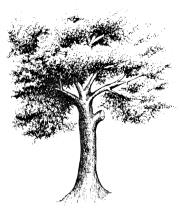
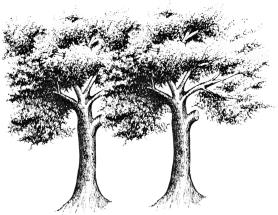
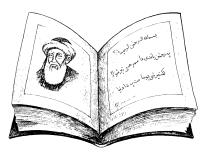
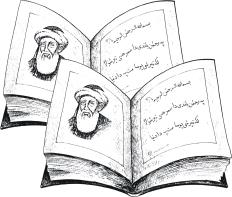
Now you can substitute other adjectives from the list.
Recognising feminine plural nouns and adjectives
- Feminine singular and adjectives ending in ه - a with the suffix ې - e for their plural forms.
| haghá qaabíla khuza da. | She is a capable woman. | هغه قابِله ښځه ده. |
| haghwée qaabíle khuze dee. | They are a capable women. | هغوی قابِلې ښځې دی. |
| hágha aspa mRa da. | That mare is dead. | هغه اسپه مړه ده. |
| hágha aspe mRe da. | That mare is dead. | هغه اسپې مړې دی. |
| haghe sara yuwa maalTá da. | She has one orange. | هغې سره یوه مالټه ده. |
| haghe sara dwa maalTé dee. | She has two oranges. | هغې سره دوه مالټې دی. |
- Feminine nouns ending in ۍ - uy do not change in their plural forms.
| zmaa tsaplúy kharáaba da. | My sandal is bad. | زما څپلۍ خرابه ده. |
| zmaa tsaplúy kharáabe dee. | My sandals are bad. | زما څپلۍ خرابه ده. |
- Feminine nouns ending in و - o and ه - a add the suffix ګانې - gaane ګانې for their plural forms.
| zmaa peeshó Randá da. | My cat is blind. | زما پیشو ړنده ده. |
| zmaa peeshogáane Randé dee. | My cats are blind. | زما پیشوګانې ړندې دی. |
| staa ghwaa gháTa da. | You cow is big | ستا غوا غټه ده. |
| staa ghwaagaane ghaTe dee. | Your cows are big. | ستا غواګانې غټې دی. |
- Words that end in a consonant are normally masculine, but there are a few feminine inanimate nouns that also end in a consonant. They become plural by adding ې - e.
| hágha zaRá bRustún da. | That is an old quilt. | هغه زړه بړستن ده. |
| hágha zaRé bRustúne dee. | They are old quilts . | هغه زړې بړستنې دی. |
- Natural gender words for family members are declined as follows:
| singular | plural | |
|---|---|---|
mother | mor مور | myande / myaande میندې / میاندې |
sister | khor خور | khwende خوېندې |
daughter | loor لُور | lóoNa / looryáane لُوڼه / لُوریانې |
NOTE:
It is very easy to confuse the following:
| moR | full (m.s.) | موړ |
| muR | dead (m.s.) | مړ |
| mor | mother | مور |
Try these sentences:
| zu moR yim. | I (m.) am full. | زه موړ یم. |
| zu muR yim. | I (f.) am dead. | زه مړ یم. |
| daa zmaa mor da. | She is my mother. | دا زما مور ده. |
| moong maaRú yoo. | We (m.) are full. | مونږ ماړه یو. |
| moong mRu yoo. | We (m.) are dead. | مونږ مړهٔ یو. |
The use of شته - shta and نشته - nishta
شته - shta and نشته - níshta are commonly used words expressing 'presence' and 'absence'.
| múshra khuza pu kor ke shta? | Is the senior lady of the house in? | مشره ښځه په کور کښې شټه؟ |
| na, dălta níshta. | No, she is not here. | نه، دلته نشته. |
| Ustáaz saahíb shta? | Is the teacher present? | اُستاذ صاحب شته؟ |
| aw, dălta shta / day. | Yes, he is here. | او، دلته شته / دے. |
| pu paakistaan ke girjáa shta? | Is there a church in Pakistan? | په پاکِستان کښې ګرجا شته؟ |
| aw, Dere shta / dee. | Yes, there are lots | او، ډېرې شته / دى. |
| tsok zanaaná kho nishta. | Are there no ladies? | څوک زنانه خو نشته. |
| pu kor ke tsok hum níshta. | There is no one at home. | په کور کښې څوک هم نشته. |
| prinsipúl seb pu dăftúr ke shta? | Is the principal in his office? | پرنسپل صېب په دفتر کښې شته؟ |
| aw, naast day. | Yes, he is sitting. | او، ناست دے. |
| staa pu jeb ke tsu shta? | Is there anything in your pocket? | ستا په جېب کښې څۀ شته؟ |
| na, heets níshta. | No, nothing. | نه، هېڅ نشته. |
NOTES:
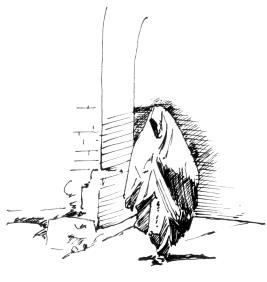
- صېب - seb is a term of respect, rather like the English word 'sir'. It is the contracted form of صاخب - saahíb.
The expression څوک زنانه نشته؟ - tsok zanaana nishta? is useful for men to ask before entering a place where women might be present.
The verb کېدل - kedúl in the present and future tenses
| taaso stúRee kégey? | Are you getting tired? | تاسو ستړی کېږئ؟ |
| na, nu stúRee kégoo. | No, we are not getting tired. | نه، نۀ ستړى کېږُو. |
| tu ghUsa kége? | Are you getting angry? | تۀ غُصه کېږې؟ |
| na, nu ghUsa kegum. | No, I am not getting angry. | نه، نۀ غُصه کېږم. |
| daa kaar kegee ku nu kegee? | Will this work happen or not happen? | دا کار کېږى کۀ نۀ کېږى؟ |
| aw, kegee | Yes, [it will] happen. | او کېږي. |
| maashoomáan óodu kegee? | Are the children going to sleep? | ماشُومان اُودۀ کېږى؟ |
| na, nu óodu kegee. | No, they are not going to sleep. | نه، نۀ اُودۀ کېږى. |
| daa wáadu kegee? | Is she getting married? | دا وادۀ کېږى؟ |
| na, nu wáadu kegee. | No, she is not getting married. | نه، نۀ وادۀ کېږى. |
| tu ba tsóomra moodá dălta paate kége? | How long will you be staying here? | تۀ به څومره موده دلته پاتې کېږې؟ |
| zu ba dwuo kaalo pore paate kegum. | I will be staying here for two years. | زۀ به دؤو کالُو پورې پاتې کېږم. |
| daa mRa kegee? | Is she dying? | دا مړه کېږى؟ |
| aw, hăr yo kas ba muR kegee. | Yes, everyone will die. | او، هر يو کس به مړ کېږى. |
NOTES:
The verb کېدل - kedúl is an auxiliary verb, used with nouns, adjectives, and adverbs to form intransitive (stative) compound verbs. For example, مړ کېدل - muR kedul (to become dead) i.e. 'to die' and وادهٔ کېدل - waadu kedul (to become married). These types of combinations are common in Pukhto.
Transitive and intransitive verbs are introduced in more detail in Lessons Seven and Eight.
Recognising plural nouns
There are several nouns, especially liquids and grains, which are considered plural in Pukhto. It is worth memorizing the more common ones. Here are a few of them:
| chaay [che] | tea (f.pl.) | چائې |
| cholé | beans (f.pl.) | چولې |
| ghanúm | wheat (m.pl.) | غنم |
| jaamé | clothes (f.pl.) | جامې |
| joo`áar | maize (m.pl.) | جوار |
| maastú | yogurt (m.pl.) | ماستهٔ |
| maazghú | brain (m.pl.) | مازغهٔ |
| orbúshe | barlay (f.pl.) | وربشې |
| puy | milk (f.pl.) | پۍ |
| shaat | honay (m.pl.) | شات |
| sholé | rice (plant) | شولې |
| shUmlé | curd (f.pl.) | شملې |
| tel | oil (m.pl.) | تېل |
| oobú | water (f.pl.) | اُوبهٔ |
| zúhar | poison (n.pl.) | زهر |
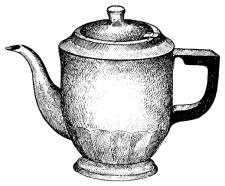
These plural words include uncountable nouns like چائې - chaay (tea) and پۍ - puy (milk) and a few countable nouns such as مازغهٔ - maazghú (brain).
Comprehension drill: Identifying numbers on a calendar
Use a calendar to learn the numbers 1–31.
👆 First learn the numbers in order, and then try practising them out of order. Start by pointing to the numbers as your teacher calls them out, then try to name the correct number as your teacher points. The new numbers are:
| yo-eesh 21 | یوویشت ۲۱ |
| dwa-weesh 22 | دوه ویشت ۲۲ |
| dúrweesht 23 | درویشت ۲۳ |
| tsalereesht 24 | څلېريشت ۲۴ |
| peenz-eesht 25 | پینځهٔ ویشت ۲۵ |
| shpugeesht 26 | ښپږیشت ۲۶ |
| oowú-eesht 27 | اووهٔ ویشت ۲۷ |
| atú-weesht 28 | اتهٔ ویشت ۲۸ |
| yo kam dersh 29 | یو کم دېرش ۲۹ |
| dersh 30 | دېرش ۳۰ |
| yo dersh 31 | یو دېرش ۳۱ |
More parts of the body
These examples are all feminine in gender:
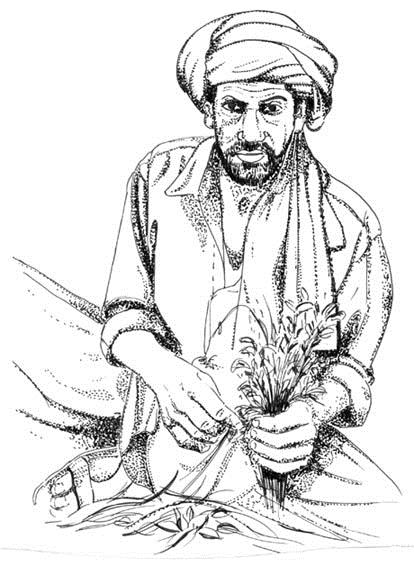
Memorising Moment
متلونه - matalóona
👆 In collecting language information it is helpful to be able to write in phonetic script. Try writing the phonetics for this maˈtəl after your language helper has said it a few times:
Now memorise it and learn its usage.
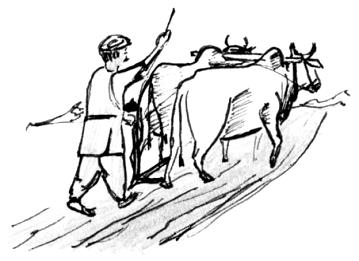
Exercises for Lesson Six
- Practice describing people, animals and objects with the following sentences:
| haghá saRáy day. | He is a man. | هغه سړے دے. |
| haghá tsínga saRáy day? | What kind of man is he? | هغه څنګه سړے دے؟ |
| haghá takRá saRáy day. | He is a strong man. | هغه تکړه سړے دے. |
Now start with these sentences:
| daa loor da. | دا لُور ده. |
| pu kor ke spay shta? | په کور کښې سبے شته؟ |
| staa aas shta? | ستا اس شته؟ |
| daa khuza da. | دا ښځه ده. |
| haghwee pukhtane dee. | هغوی پښتنې دی. |
👆 Find a children’s picture book or use Picture It in Dari and Pashto and have friends give adjectives to describe the pictures. Make a list of the adjectives you have learned.
- Replace the bold word in the following sentence with the words listed below:
| zmaa daa kitaab khwax day. | I like this book. | زما دا کتاب خوښ دے. |
Then make the sentences negative.
- Repeat exercise 2. with these feminine nouns:
- Make the following singular feminine nouns and adjectives plural.
- Using the question دا څه شے دے؟ - daa tsu shay day? point to the following parts of the body:
